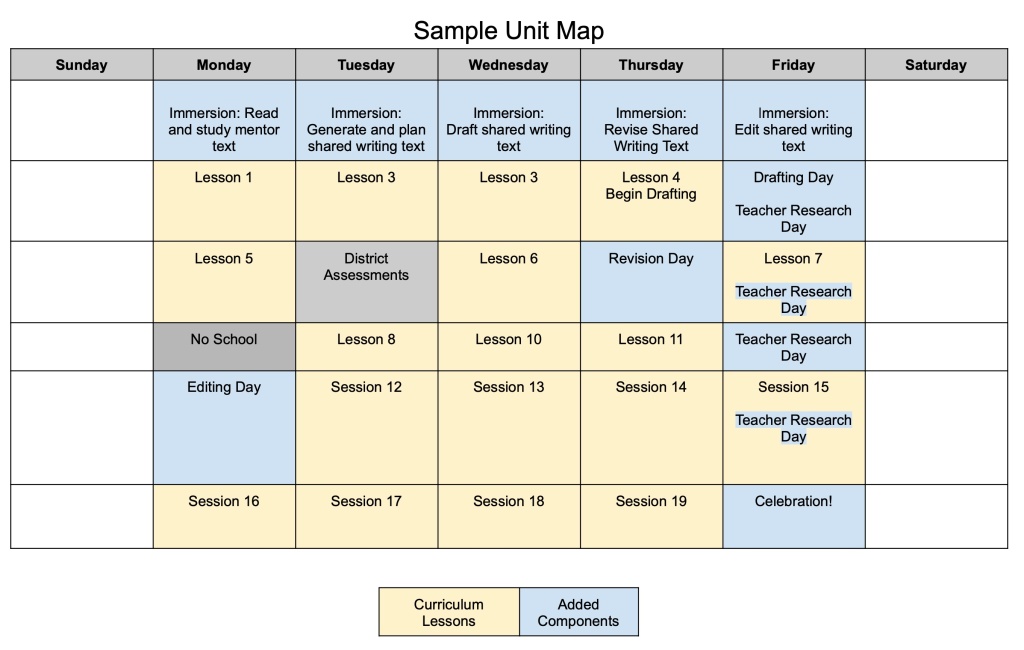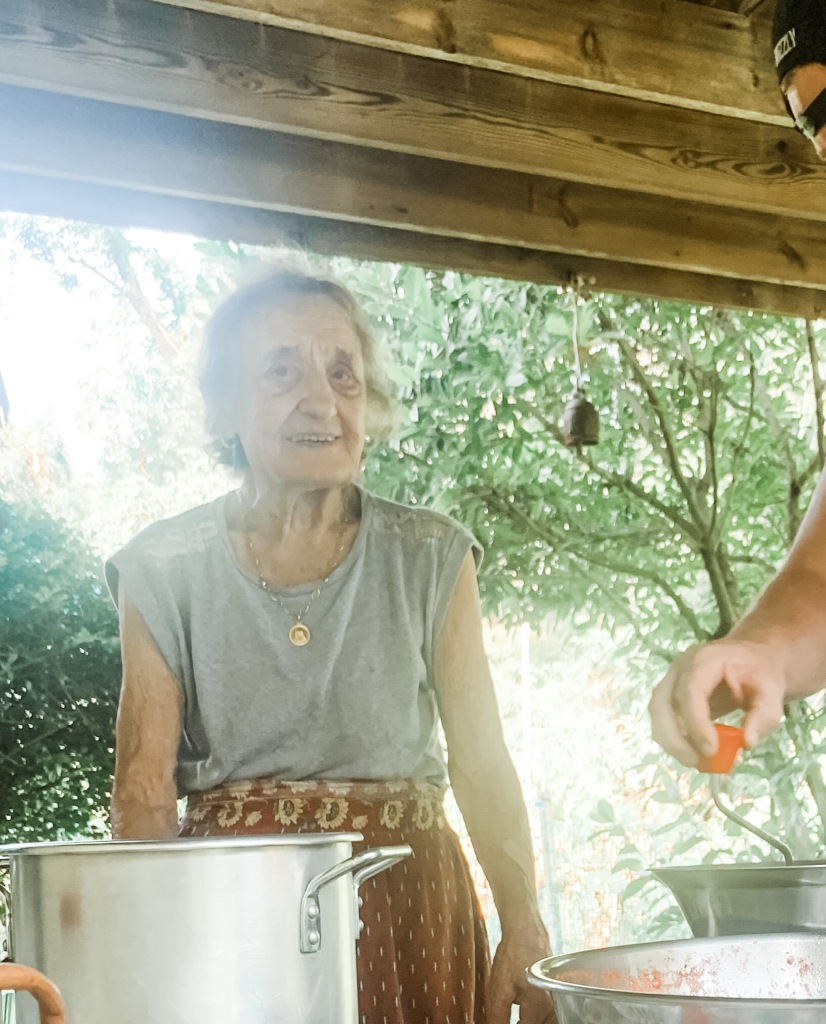I grew up cooking with my Grandma. She had a massive garden and we were always whipping something up using the vegetables she grew. All of my Grandmother’s recipes came from her memory and her heart. Whether we were making zucchini bread, eggplant parmesan, or homemade tomato sauce…there was never a recipe in sight. A quick stir or taste always told my Grandma what we needed to add. She responded to what was in front of her. My Grandma’s research was in the tasting and the stirring, mine was in the watching, observing her and her process. I watched, observed and learned. She invited me to try. She showed me her process, her creative ways. After years of teaching and coaching I know that teaching, like cooking, is a creative process.
Early in July, Dr. Rachel Gabriel, from the University of Connecticut, Tweeted a thread that has had me thinking about my Grandma and about teaching. She wrote, “Curriculum is like jarred spaghetti sauce. Some add ingredients to improve it because they know how to cook, but don’t have time to start from scratch.” As an elementary literacy coach, I’m always looking for ways to support teachers in this process of adding ingredients to our curriculum, in order to truly make their work responsive to the students in their class. This thread captured so much of what I had been reflecting on as our school year ended and I began to envision moving into a new school year.
Last spring, we worked with our TCRWP Staff Developer to take a close look at our students’ writing in grades kindergarten through second grade. After celebrating progress made since the beginning of the year, it was time to reflect on what the writing told us about our instruction. Here were some key things we noticed and immediately began thinking about how we could address:
- Volume was down compared to what we had previously seen from students in the past. We wondered if part of this could be related to letter formation fluency.
- The pieces didn’t have a clear sense of structure. We wondered if students really understood the kind of writing they were attempting.
- We also saw opportunities to tighten up the writing process and wondered what would happen if we put a greater emphasis on the planning phase.
With the help of our staff developer, we mapped out our next units of study, thinking about what ingredients would help us to address some of the areas we noticed need some attention.
- We decided to add three to five days of immersion work before officially launching the unit lessons.
- We made plans to study mentors and use shared writing to co-create pieces with students, before we ever asked students to write.
Adding this time and these practices to our curriculum calendar also helped me to build in opportunities to work with grade level teams to really understand the genre they were teaching and think about what mentors and shared texts could look like. Together we created a collective vision, among students and teachers of what we were working towards.
In June, when I met with our first grade team to calibrate scoring of final on-demand pieces, I saw the benefits that came from these added ingredients.
- There was evidence of students planning across pages.
- Students were writing with clear structures that showed their knowledge of the genre.
- There was greater use of a variety of elaboration strategies.
- An unintended celebration was the students’ drawings. Across the board, we noticed that students’ drawings really added to their writing.
In the span of one writing unit, we saw so much growth because of the additions we made to the unit. The writing felt purposeful and we had a lot to celebrate. We also made notes about what we could replicate, across units and I thought about what this work could look like across grade levels.
This kind of curriculum mapping can be so valuable in making space for instructional components that may not be explicitly spelled out within a curriculum. Thinking about what we value, what students need, and what we want to make space for is important work to do before a unit begins. I have found blank calendars and time with colleagues invaluable tools for supporting this kind of planning. Immersion is not the only ingredient that can help enhance your writing workshop. Here are a list of ingredients that you might consider:
Immersion
Make time before beginning a new unit of study to expose students to the genre. This may include reading and studying mentor texts and co-creating texts through shared writing. The pieces of writing produced during shared writing can be brought out again for additional shared writing or interactive writing opportunities as you progress through a unit of study. They can also serve as additional mentor texts.
Research Days
It may be helpful to leave one day during the week to observe students working during the workshop. In his essay in The Teacher You Want to Be, Tom Newkirk reminds us that “ researchers can presume to make teaching a true science, to provide a “solid” base for action…” Taking time to watch what students are doing, you may notice how they are moving through the writing process, how they are utilizing tools and charts, and even read over their shoulder to begin to plan celebrations and next steps. This can be time well spent if you use it to plan mini lessons, conferences, and small groups to follow up on your observations and get to know the children as writers. It also sends a message to students about the culture of learning in your classroom.
Drafting Days
Some curriculums expect students to draft quickly or even for homework. If you find that your students benefit from additional drafting time, then plan for it as part of your unit.
Revision Days
I often hear teachers report that there are kids that are just unwilling to revise their work. If that’s the case for your class or a small group of students, consider adding special revision days to the calendar. These can be days where you pull out fun revision supplies and highlight revision strategies that can benefit the work your students are doing. A spotlight on revision can make it exciting.
Editing Days
Maybe, through research, you begin to notice that your students need explicit instruction on an editing strategy or skill that hasn’t come up in your curriculum. These are fantastic opportunities to add additional lessons to your curriculum map.
Days Off and Disruptions to The Schedule
We all know that there are plenty of disruptions to the schedule. When planning a unit, we should be realistic and plan for things that may interrupt the flow. When we think ahead to what might interrupt a unit, we can be better prepared to maximize time and maintain momentum.
Celebrations
Writing for a purpose adds a layer of investment for students. If students know that they will be sharing their writing with others at the end of a unit, this can help to keep the energy alive throughout a unit.
Back in the kitchen with my Grandma, I watched, I listened, and I learned as she added ingredient by ingredient through tasting and stirring. Our work in classrooms alongside children and our work in schools alongside colleagues offers us many opportunities to discover what might be missing and what might need to be added. When we take this time to notice, plan, and reflect- we can then relish those moments when everything tastes just right.
A set of blank 22-23 calendars for you to begin to try this work yourself:
Blank Calendars for 22-23 School Year
References
Glover, Matt, and Ellin Oliver Keene. 2015. The Teacher You Want to Be. Portsmouth, NH: Heinemann.





I love this metaphor, and love the suggestions of how we can enhance the curriculum in place. Thanks, too, for the blank calendars. I don’t know why, but I both find it super helpful to have blank calendar pages for the year and can’t manage to get them for myself. It’s such a little thing, but is so helpful!
LikeLiked by 1 person
I also have trouble finding free printable calendars- just plain and simple. That’s why I’ve started to make my own. Best of luck to you this school year! ❤️
LikeLike
I love the idea of an emphasis on ingredients! The big picture outcomes may be the same, and what we put into it to add flavor and flair makes the recipe our own. Finding my own way through this as my school adopts a curriculum I’m definitely going to use this metaphor and the different ingredients to respond to student (and teacher) needs.
LikeLiked by 1 person
I’m that person who adds things like fresh basil and Gardein “beef” crumbles to the premade sauce so I could totally relate to this metaphor! I think it’s so important to build in extra time for drafting since not every kid takes the same amount of time to draft. Small groups can be taught to kids who are finished drafting to help them with something else. But no one should be penalized with take-home writing due to a lack of drafting days.
Also, the immersion days are so important. Professional book after professional book has recommended them at the beginning of every unit. However, it too many places, those days are cut. They really shouldn’t be. They’re of critical importance since kids need to have an understanding of what it is they’re being asked to create.
LikeLiked by 1 person
This is such a perfect post to read as we begin to re-enter our schools. Here’s to a year of planning, and a year of adding some spice to our units to satisfy our children’s tastes! Your grandmother is smiling!
LikeLiked by 1 person